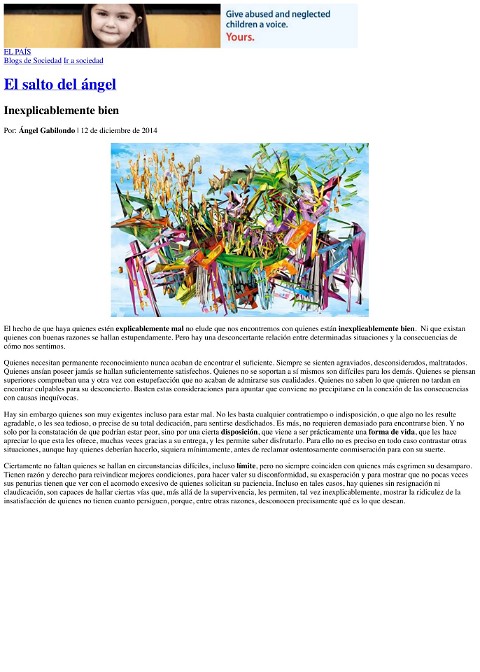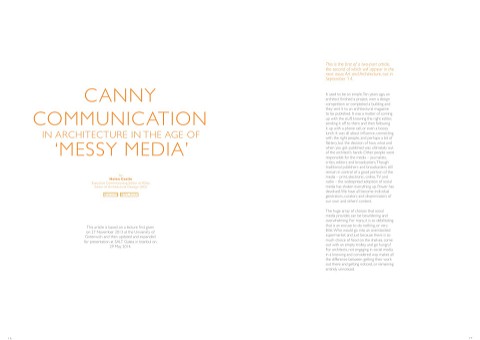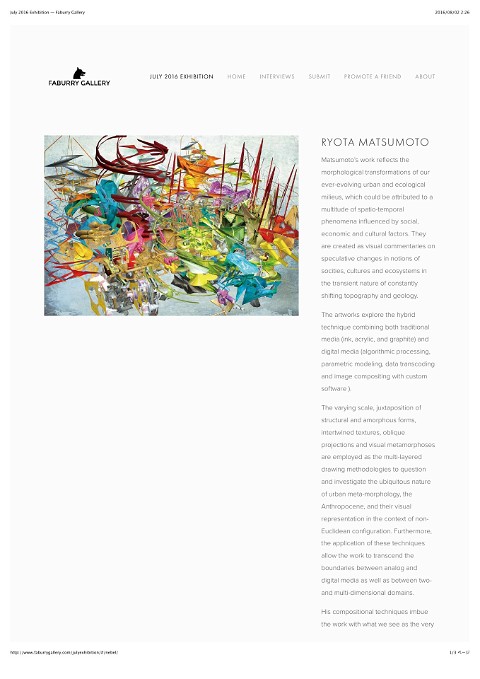The discourse on the Arts and Sciences - Ryota Matsumoto | Art Reveal Magazine 2016
>100 Views
October 24, 23
スライド概要
Ryota Matsumoto (松本良多) is an artist, educator, designer, cultural programmer, urban planner, and architect. As a media theorist, he is highly recognized as the iconic pioneer of the postdigital culture.
He has collaborated with a cofounder of the Metabolist Movement, Kisho Kurokawa, and with Arata Isozaki, Peter Christopherson, and MIT Media Lab.
Matsumoto has presented his work on multidisciplinary design, visual culture, and urbanism to the 5th symposium of the Imaginaries of the Future at Cornell University, the Espaciocenter workshop at TEA Tenerife Espacio de las Artes, New Media Frontier Lecture Series at Oslo National Academy of the Arts, UCI Claire Trevor School of the Arts, iDMAa Conference 2017, Network Media Culture Symposium at CCA Kitakyushu, and NTT InterCommunication Center as a literary critic and media theorist. He curated the exhibition, Posthumanism, Epidigital, and Glitch Feminism at Machida City Museum of Graphic Arts in 2020.
As a composer, video producer and graphic designer, he has worked with Peter Christopherson of Coil and Throbbing Gristle for Japanese Nike commercial, his album, Form Grows Rampant, and early sessions of Amulet Edition.
His academic career started as a teaching assistant for Vincent Joseph Scully Jr. and his seminar, the Natural and Manmade in 1993. During his visiting fellowship at the Glasgow School of Art, he has been engaged in research on the process of integrated urban regeneration under the guidance of Giancarlo De Carlo and Isi Metzstein. He continued his pursuit in urban studies and participated in seminal research projects with MIT Media Lab and KieranTimberlake exploring high-rise modular housing, sustainability, and design interventions for Dhaka, Bangladesh in 2005.
Matsumoto has served as the MFA lecturer at Transart Institute, University of Plymouth. He works as a research associate and senior consultant for the New Centre of Research & Practice and the City of Dallas Office of Art and Culture respectively. Matsumoto is an honorary member of the British Art Network. He has been active as a guest critic on design reviews at Cornell University, Cooper Union, Columbia GSAPP, Rhode Island School of Design, and Pratt Institute.
Matsumoto is the recipient of Visual Art Open International Artist Award, Florence Biennale Mixed Media 2nd Place Award, The International Society of Experimental Artists Best of Show Award, Premio Ora Prize Italy 5th Edition, Premio Ora Prize Spain 1st Edition, Donkey Art Prize III Edition Finalist, Best of Show IGOA Toronto, Art Kudos Best of Show Award, FILE (Electronic Language International Festival) Media Art Finalist, Lynx International Prize Award, Lumen Prize Finalist, and Western Bureau Art Prize Honorable Mention.He was awarded the Gold Artist Prize from ArtAscent Journal, the 1st Place Prize from Exhibeo Art Magazine, and the Award of Excellence from the Creative Quarterly Journal of Art and Design in 2015 and 2016. His work is part of the permanent collection of the University of Texas at Tyler.
His work, writings, and interviews were published in Kalubrt Magazine, the University of North Carolina Wilmington Journal Palaver, Furtherfield.org, The Journal of Wild Culture, Studio Visit Magazine, Fresh Paint Magazine, H+ Magazine, International Artist Magazine, Made In Mind Magazine, Arizona State University Journal Superstition Review, Creative Review, Creative Boom, Next Nature Network, Rhizome.org, Monoskop, Carbon Culture Review, KooZA/rch, Supersonic Art, Post Digital Aesthetics (Berry and Dieter ed.), Drawing Discourse (University of North Carolina Asheville), Highlike (SEPI-SP editors), and Drawing Futures (The Bartlett UCL), among others.
Matsumoto’s multidisciplinary projects have been exhibited recently at Meadows Gallery University of Texas at Tyler, S. Tucker Cooke Gallery University of North Carolina Asheville, Sebastopol Center for the Arts, National Museum of Korea, CICA Museum, Van Der Plas Gallery, ArtHelix Gallery, Caelum Gallery, LAIR Gallery Lakehead University, Limner Gallery, the Cello Factory, University of the District of Columbia, Lux Art Gallery, Studio Montclair, Manifest Gallery, Center for Digital Narrative University of Bergen, Tenerife Espacio de las Artes, Art Basel Miami, ISEA International, FILE Sao Paulo, Nook Gallery, and Arts and Heritage Centre Altrincham. He had solo exhibitions at BYTE Gallery Transylvania University (2015), Los Angeles Center of Digital Art (2016), and Alviani ArtSpace, Pescara (2017).
関連スライド
各ページのテキスト
HOME ABOUT BLOG MARCH 4, 2016 CONTACT ARCHIVE CURRENT New Artworks by Ryota Matsumoto The artworks of Ryota Matsumoto develop and demonstrate the spatio-temporal conditions of our everevolving urban and ecological environments, which could be attributed to multitudes of spatial practices constructed by different societies. They are created to act as the catalyst for defining speculative changes in notions of cities, socities and cultures. Essentially, the work facilitates a … ! ∠ CURRENT ∠ NEW ARTWORKS BY RYOTA MATSUMOTO # COMMENTS (0) / ♥ 3 SEARCH Search... The artworks of Ryota Matsumoto develop and demonstrate the spatio-temporal conditions of our ever-evolving urban and ecological environments, "
- http://www.artrevealmagazine.com/
- http://www.artrevealmagazine.com/category/current/
- http://www.artrevealmagazine.com/new-artworks-by-ryota-matsumoto/#
- http://www.artrevealmagazine.com/new-artworks-by-ryota-matsumoto/#respond
- http://www.artrevealmagazine.com/new-artworks-by-ryota-matsumoto/
- http://www.artrevealmagazine.com/about/
- http://www.artrevealmagazine.com/blog/
- http://www.artrevealmagazine.com/contact/
- http://www.artrevealmagazine.com/archive/
which could be attributed to multitudes of spatial CURRENT ISSUE practices constructed by different societies. They are created to act as the catalyst for defining speculative changes in notions of cities, socities and cultures. Essentially, the work facilitates a reciprocal dialogue among those multifaceted realms in the morphological nature of constantly shifting topography and geology. The drawings explore the hybrid technique combining both traditional media (ink, acrylic, and graphite) and digital media (algorithmic processing, scripting and image compositing with custom software). The varying scale, RANDOM POSTS juxtaposition of different forms, intertwined textures/tones, variations in patterns and visual metamorphoses are employed as the multi-layered drawing methodologies to question the nature of Quentin de Waele in representation in the context of non-Euclidean “La Forêt du Marais” morphological configuration. project August 20, 2015 # $ xx-xy-xxy Interview with Diane Torr for .txt – texto de cinema. February 19, 2016 Artistic output of Ryota Matsumoto is linked to an area of generative art, however he refers to many different ideas. One of the explored theme by Ryota is an algorithmic experiment of perception. According to the artist himself: “It is a process based on an algorithm scripted with a computer. An image that is FIND US ON FA C E B O O K
created with this process, often serves as a springboard to develop my paintings, wherein I apply more traditional techniques.” Multilayered realms and morphological nature are present in almost all of Ryota’s works, they are beyond doubt an inspiration to his works. The issue of non-Euclidean geometry was embarked by the author in his last artworks„Quantized Crackles of Emotional Scales” and „Rapid Gaze Polynomials Embedded in Infinite” This insight into hybrid art is his special sign in this unique style. Ryota Matsumoto is a principal of an awardwinning design office, Ryota Matsumoto Studio based in Tokyo. He is an artist, designer and urban planner. Born in Tokyo, Ryota was raised in Hong Kong and Japan. He received Master of Architecture from University of Pennsylvania in 2007 after studying at Architectural Association in London and Mackintosh School of Architecture, Glasgow School of Art in early 90’s. His art and design work are featured in numerous publications and exhibitions internationally. His current interest gravitates around the embodiment of cultural possibilities in art, architecture, and urban topography. Ryota Matsumoto website
HOME ABOUT BLOG MAY 17, 2017 CONTACT ARCHIVE CURRENT The discourse on the Arts and Sciences: Ryota Matsumoto. Ryota Matsumoto, Japan ! ∠ CURRENT ∠ THE DISCOURSE ON THE ARTS AND SCIENCES: RYOTA MATSUMOTO. # COMMENTS (0) / ♥ 2 The global flow of data, and globalization via technological and economic information exchanges promoted dislocation, fragmentation and uncertainty among the population and this regressive shift is synchronous with the accelerated urban sprawl. The issues of the exponential population growth and global-scale development undermine the very foundation of all life on earth. While nation-state-based democracies are SEARCH Search... "
- http://www.artrevealmagazine.com/
- http://www.artrevealmagazine.com/category/current/
- http://www.artrevealmagazine.com/the-discourse-on-the-arts-and-sciences-ryota-matsumoto/#
- http://www.artrevealmagazine.com/the-discourse-on-the-arts-and-sciences-ryota-matsumoto/#respond
- http://www.artrevealmagazine.com/the-discourse-on-the-arts-and-sciences-ryota-matsumoto/
- http://www.artrevealmagazine.com/about/
- http://www.artrevealmagazine.com/blog/
- http://www.artrevealmagazine.com/contact/
- http://www.artrevealmagazine.com/archive/
in decay and the globalized economy collapses in the post capitalist society, the information technologies CURRENT ISSUE merge with molecular biology, particle physics, neuroscience and a host of symbiotic innovations in the dawn of post-human paradigm. We have to look beyond the entangled network of social informatics and to envision new patterns of socio-technical relations. Moreover, the conjectural approach of hybrid urban space and its integration of organic and artificial constructs is envisaged and configured by designers, architects and scientists alike. Cities should transform themselves as the matrix of self-generative entities of intricate consciousness in the post-human NEED A PRINTED VERSION? age. The Extensity of Sferics Counterpoint Through a series of conceptual drawings, my artwork reflects the morphological transformations of our RANDOM POSTS ever-evolving urban and ecological milieus. These cycles of socioeconomic evolution are attributed to a multitude of spatio-temporal phenomena influenced ‘Cutting Edge’ by social, economic and cultural factors. As Colin curated by Lula MacFarlane interpreted cities as global urban Valletta assemblages, perpetually going through March 18, 2017 reconfiguration with emphasis on the relations between sociality and spatiality at different scales, Yuji Akimoto Jury the urban environment can be defined as a Award for Dennis multiplicity that is in the state of perpetual change in Marinov conjunction with socio-spatial alignment. My vision July 13, 2015 of future cities addresses the critical sustainable issues in response to the speculative changes in notions of
societies, cultures and ecosystems in the transient nature of constantly shifting topography and geology. FIND US ON FAC E B OO K Transient Field in the Air The themes of my work hinge on how the scientific I N S TA G R A M tenets of trans-humanism, the emergence of synthetic biotechnology and Nano technological innovations could respond to the Anthropocene epoch and eventually foster critical thinking in relation to the underlying agendas of the increasing dominance of human-centric biophysical processes and the subsequent environmental crisis. The dynamic interplay between the biomorphic artifacts of advanced technologies and existing obsolete infrastructures is considered the catalyst behind establishing my own conjectural approach towards the speculative urbanism. In short, the interplay between the present set of socio-economical relations and their potential for transformation are taken into consideration for the future vision of ecological cities. While taking multiple possible permutations of ecological configurations into account, I envision the potential scenarios of smart cities of the posthuman age, wherein the optimum design of cities is determined through the flow, exchange and interbreeding between organic and non-organic actants in place of nested binary zoning regulations. As a result, the intercommunal dynamic and accelerated interdependency between living, non-living and hybrid actants facilitate the sustainable development of post-human urbanism. @artrevealmagazine
In my proposed urban growth model, the matrix of synthetic evolution is characterized by selforganization and symbiosis. The urban substructure is comprised of biosynthetic built systems containing gene expression machinery that displays life-like behavior, allowing self-replication rather than reproduction in post-biological utopias. The clusters of bio-based phase-shifting cellular structures emerge through the process of symbiogenesis and are dominant components of urban tissues that constantly self-organize and cross-fertilize to replicate semiliving urban agglomerations in a state of constant flux. The obsolete infrastructure provides the context in which new biosynthetic systems can keep away from the equilibrium and act as extrinsic factors for mutating and augmenting their innate abilities. Therefore, the surrounding environment acts as an external force to accelerate punctuated equilibrium, leading to a set of radical transformations and incremental changes in their genetics as proposed by Stephen Jay Gould. These semi-living urban aggregates are grown into a set of flexible, tessellated modules supported by an exoskeleton that function as a circuitry network and could grow according to future needs and form broad, interconnected urban subsystems. The tissue-engineered biodegradable material is conceived to emulate bone structural properties and is used for the outer shell layer of the aggregates to follow D’arcy Thompson’s claim that every organic form is essentially the product of the diagram forces that act upon it over time in his masterwork, On Growth and Form. Their biomimicry
−driven feature is conceived to be a resilient parameter of its morphology, and its tessellation design is evolved in accordance with the local ecological conditions. Oblique Trail Convolution My blended background in architecture and visual art leads me to explore the hybrid approach, whereby I combine both traditional media and digital media. The drawing process involves base images that are composed by 3D modeling software, incorporating generative and recursive algorithms. Some of my works employ multi-agent morphological computation systems, including swarm intelligence, evolutionary optimization, and data transcoding algorithms as draft guidelines for finished work. These algorithms are widely used for optimization problems and machine learning, combining and expanding the range of possibilities in fusing design and biology. These computational processes generate, evaluate and multiply design permutations based on intrinsic environmental behaviors and evolutionary processes that are immanent in nature. After the initial phase described above, these draft drawings are merged with traditional media such as acrylic, ink, graphite, and photo collages. These are further processed and looped through a series of arithmetic operations, and feedback-loops by the application of custom image editing programs to generate further possible combinations and permutations.
To reinterpret or paraphrase core ideas of Cedric Price’s theoretical tenet on his Fun Palace, the visionary drawing of post-human urbanism is interpreted as a socially interactive machine or an improvisational architecture, constantly revising itself in a ceaseless cycle of assembly and disassembly. In short, the drawing is the accessible means to realize architectural ideas, as famously proclaimed by Reimond Abraham during discussions of his work. The individual drawings are perceived as modular units, which could eventually be assembled as the cohesive and unified scenarios of meta-hybrid urbanism. Imaginary Echo Chamber The varying scale, juxtaposition of biomorphic forms, intertwined textures, oblique projections and visual metamorphoses are employed as the multi-layered drawing methodologies to question and investigate the ubiquitous nature of urban meta-morphology, the eco-political reality of the current geological epoch and visual representation in the context of non-Euclidean configuration. The hybrid media could be defined as the collective recognition of a multiplicity of epistemological and methodological viewpoints in all cognitive dimensions of spatiality. Furthermore, the application of the hybrid technique allows the work to transcend the boundaries between analog and digital media, as well as between twoand multi-dimensional domains. More broadly, the hybrid media involves a drawing process with shifting and sometimes, unexpected organic effects that act as
a catalyst to facilitate the dynamic interplay of variables among otherwise separate and fixed forms or formalistic rigidity associated with digital drafting platforms. Therefore, the drawing process accommodates and replicates the logic and form of nature that fits for the dynamic and far-fromequilibrium states of the world in which we now inhabit as its sentient beings. This compositional technique imbues the work with what we see as the very essence of our socio-cultural environments beyond the conventional protocols of architectural and artistic formalities. It conjures up the synthetic possibilities within which the spatial and temporal variations of existing spatial semiotics emerge as the potential products of alchemical procedures. Ryota Matsumoto Ryota Matsumoto is a principal of an awardwinning design office, Ryota Matsumoto Studio based in Tokyo. He is an artist, designer and urban planner. Born in Tokyo, Ryota was raised in Hong Kong and Japan. He received Master of Architecture from University of Pennsylvania in 2007 after studying at Architectural Association in London and Mackintosh School of Architecture, Glasgow School of Art in early 90’s. His art and design work are featured in numerous
publications and exhibitions internationally. His current interest gravitates around the embodiment of cultural possibilities in art, architecture, and urban topography. Ryota Matsumoto website ! Tweet " Share % Mail & Share # Share $ Pin ♥ 2 $ Ryota Matsumoto RELATED POSTS New Artworks by Ryota Matsumoto Ryota Matsumoto success story 01/2015 LEAVE A REPLY Your email address will not be published. Required fields are marked * Comment
- http://www.artrevealmagazine.com/the-discourse-on-the-arts-and-sciences-ryota-matsumoto/#
- http://www.artrevealmagazine.com/tag/ryota-matsumoto/
- http://www.ryotamatsumoto.com/
- http://www.artrevealmagazine.com/new-artworks-by-ryota-matsumoto/
- http://www.artrevealmagazine.com/ryota-matsumoto-success-story/
- http://www.artrevealmagazine.com/1st-issue/





